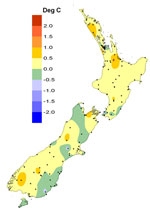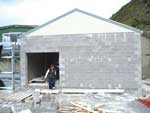PDF of this article (276 KB)







Sheryl Miller describes how NIWA and the Hongoeka Development Trust are collaborating on New Zealand’s first low-cost, land-based polyculture system.
In New Zealand, the images associated with aquaculture are of bobbing black buoys on the water surface, clusters of mussels hanging below from longlines, or cages of salmon close to the shore. Now NIWA and Hongoeka Development Trust Ltd (HDT) are adding a new image, bringing aquaculture up onto the land and moving from monoculture to environmentally sustainable polyculture.
Several years ago, HDT asked NIWA’s advice on possible uses for a strip of coastal land that their people own at Plimmerton, just north of Wellington. With funding from the Foundation for Research, Science & Technology, we began a joint project to investigate a low-cost way for coastal Māori to engage in land-based polyculture. Māori are considerably less involved in land-based aquaculture than in customary and commercial wild fisheries, partly due to high capital costs, and often because conventional aquaculture activities are not readily available to coastal Māori.
The project’s objectives include designing new water-recycling and polyculture technologies and developing appropriate husbandry techniques; the goal is to create an economically sustainable system accessible to coastal Māori. HDT sees it as a way of encouraging mokopuna back to tribal areas, through the provision of sustainable employment and a source of customary foods.
Pilot study and a full-scale system
Following the decision to establish a polyculture system at Plimmerton, we began our research with a 1/8 scale pilot system at NIWA’s Mahanga Bay Aquaculture facility in Wellington. Paua (New Zealand abalone – Haliotis iris) was chosen as the primary crop. We developed novel water-recirculation technologies to ensure that suspended solids, faecal material, and excess nitrogen are removed from the seawater before it is returned to trays containing the paua. Several variables have been monitored within the system, including suspended solids and particle size, pH, ammonium, oxygen consumption, and temperature.
The full-scale system designed for Plimmerton holds 1 tonne of paua, has a volume of 23 m3 seawater, a flow rate through the system of 40 m3/h, and 3 m3 of new seawater entering the system daily. Tipper buckets empty the water into multi-layered trays, each holding up to 40 kg of paua. The water movement suspends the organic wastes (faeces and food particles), making the trays self-cleaning and reducing the labour requirement. Suspended solids are carried through to tanks with filterfeeding bivalves before passing to a settling basin and then through foam fractionators (also known as protein skimmers), which further remove organic compounds such as particles, detritus, and bacteria. The water continues through tanks of seaweed to remove excess nitrogen, particularly ammonium, and then returns to the paua trays. The system is modular, so more tanks and species can be added.
Finding the right species mix
The system is designed to initially contain three species, and has been set to run at optimal growing conditions for paua, based on an initial stocking size of 20–30 mm: flowing water at 18–20 °C, and pH 7.8–8.2. The paua are fed an artificial diet, occasionally supplemented with seaweed, and are kept in a darkened room, as they actively feed at night. In our pilot system, which is stocked with 125 kg of paua, growth and weight increased exponentially over time, with growth rates ranging from 50 to 100 μm per day (depending on variables such as stocking density and temperature).
We began with Pacific oysters (or tio, Crassostrea gigas) as the filter-feeding bivalve to remove the suspended solids washed out of the paua trays. However, oysters had high mortality, with their shells thinning and becoming brittle, so we replaced them with blue mussels (Mytilus galloprovincialis), which show better survival in the system.
An additional species trialled was the sea cucumber (Stichopus mollis). Experiments show that, on average, 135 sea cucumbers could potentially remove all the organic waste produced by 125 kg of paua. However, the sea cucumbers could only grow on the waste of paua fed a diet of fresh algae or kelp flakes, not the artificial diet currently used in the pauafarming industry. Future research may lead to an artificial diet for paua with a higher percentage of seaweed (macroalgae).
To prevent a build-up of ammonium within the system, the seawater is passed through tanks of seaweed, which essentially sucks up the excess ammonium and uses it to maintain growth. We’re testing two species of red seaweed, Porphyra (Māori name karengo). Growth rates of Porphyra virididentata and P. cinnamomea, local to the Wellington region, have been trialled at high and low water flow. Overall, both species grew better at higher water flows. However, optimal growth temperature for Porphyra is lower than that for paua, so we’re still investigating growth and ammonium uptake at various temperatures.
Watch this space
As this issue of Water & Atmosphere goes to press, the system at Plimmerton is close to completion. Once the facility is up and running, NIWA and HDT plan to continue their collaboration by running a training course at Plimmerton that combines the theory of paua farming and water quality management with practical experience they have gained from setting up and maintaining a polyculture system. HDT’s vision is to include the polyculture system as part of an ecotourism venture.
What is polyculture?
Polyculture is the concept of growing two or more complementary species together in a single sustainable system, as opposed to aquaculture, which involves the propagation and rearing of a single aquatic species. The goal of polyculture is to increase productivity of several species by efficient use of ecological resources. The productivity and waste of the primary polyculture species maintains the production of supplementary species. It’s not a new concept, having been practiced in China for more than 1000 years.
Polyculturing paua
- NIWA and HDT are constructing a land-based polyculture facility on Māori land near Plimmerton.
- NIWA has used a scale model of the system to develop an innovative recirculation system and to test various species.
- In addition to producing paua, future plans for the facility include training courses and ecotourism.
Further reading and useful link
Lutz, C.G. (2003). Principles of polyculture. Aquaculture Magazine 29(2): 34–39.
To learn more about aquatic polyculture, visit the University of Auburn webpage: www.ag.auburn.edu/fish/international/polycul.htm
Dr Sheryl Miller (Ngāi Tahu, Kāti Mamoe, Waitaha) specialises in seaweed ecophysiology and aquaculture, as well as biosecurity issues. She works with Te Kūwaha o Taihoro Nukurangi (NIWA’s Māori Research and Development Unit) and is based in Wellington.
This project is funded through the FRST research programme ‘Developing a Low-cost Aquaculture System Accessible to Coastal Iwi’. Special thanks go to NIWA staff Dr Phil Heath, Graeme Moss, Bob Hickman, John Illingworth, and Mike Tait, who have put in many hours developing this technology, Johnny Wright for maintaining the system, and Kimberley Maxwell for use of her MSc thesis on energy budget and potential use of sea cucumbers within the polyculture system. Thanks also to our research partners, Hongoeka Development Trust Ltd.
Teachers’ resource for NCEA Achievement Standards or Unit Standards: Biology Level 1 AS90162, US6299, Level 2 US6310 Environmental Tourism Maori Level 3 US17789 Science Level 1 AS90187, US6349, Level 3 US21613 Technology Level 1 US13389, Level 2 US13390 See other curriculum connections at www.niwa.co.nz/pubs/wa/resources
